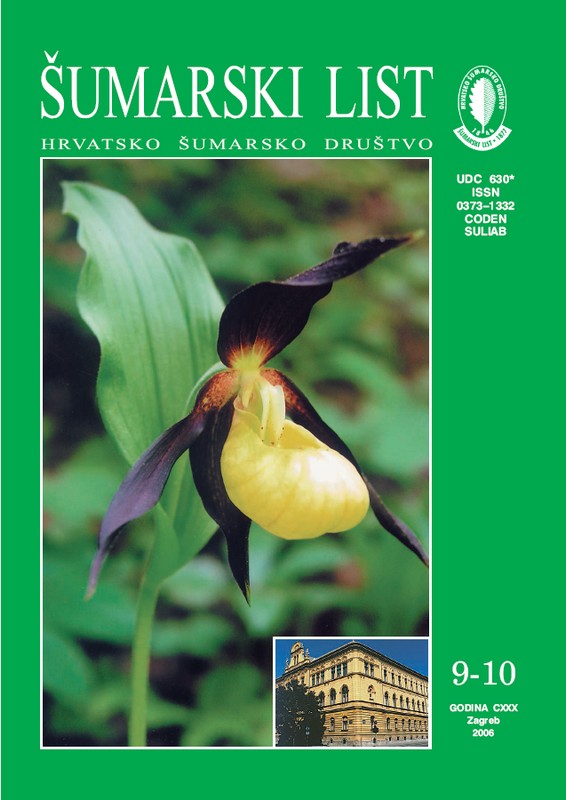
broj: 9-10/2006
pdf (21,0 MB) |
|
||||||||||||||
| IZVORNI ZNANSTVENI ČLANCI | ||
| Vukelić, J., D. Racić, D. Baričević | UDK 630* 188 (001) | |
| Phytocoenosis of Silver Fir and Hop Hornbeam (Ostryo-Abietetum/Fukarek 1963/Trinajstić 1983) in the Hinterland of Vinodol pdf HR EN | 387 | |
| Idžojtić, M., M. Glavaš, M. Zebec, R. Pernar, P. Beuk, I. Prgić | UDK 630* 442 (001) | |
| Intensity of Infection with Yellow Mistletoe and White-berried Mistletoe on the Area of the Forest Administrations Vinkovci and Nova Gradiška pdf HR EN | 399 | |
| PREGLEDNI ČLANCI | ||
| Grbac, Ivica, Renata Ojurović | UDK 630* 812 | |
| Nanotechnology Applications in the Forest-Based Industries pdf HR EN | 411 | |
| STRUČNI ČLANCI | ||
| Trinajstić, I. | UDK 630* 188 | |
| Phytosociological Faetures of the Ass. Hippophao-Berberdetum Moor 1958 (Berberidion vulgaris) in Croatia pdf HR EN | 421 | |
| Kapec, D. | UDK 630* 424 + 429 + 48 (Quercus robur L.) | |
| The Influence of Dieback Intensity, Microrelief and Sava’s Flood Water on the Condition and the Structure Pedunculate Oak’s Stands in Management Unit “Žutica” pdf HR EN | 425 | |
| Summary: The paper presents Management Unit “Žutica” through three parts. The first one presents the intensity of dieback pedunculate oak with its influences on all changes into growing stocks through every age class before,during and after the great dieback forest in 1964 and 1965. After the measurement and classification 167 854 m3 snags from its origin places compartments and subcompartments divided at 4 zonas with different intensity of dieback according to the processed data by the application of known method P. Manojlović they were formuleted in tables graphs and were mapped.The research refers maximal dropping of growing stock and areas in younger and middle-aged classes (IV., V., VI.) pedunculate oak under 93 m3 per ha and they completely disappeared from 1068,45 ha forested area(total and partial clearly dieback).The results obtained show 4 forms intensity of diebac named TOTAL DIEBACK (75–100 %), PARTIAL CLEARLY DIEBACK (50–75 %), STRONG THINY DIEBACK (30–50 %) and THINY DIEBACK (15–30 %). The second part concerns research microrelief of compartment 166 a,cross-section through,stem number distribution,height curve and the border of drying zone with the map of drying,contour line 98,00 m height above the sea level and directions of Sava input flood waters.The places of 23 compartments below that contour line had total dieback and they make the whole with compartments of partial clearly dieback around named drying zonas whose directions are in correlation with available Sava’s flood waters on october 27 of 1964. The third part according research results proved that total growing stock volume of all stands in the whole management unit after big dropping through 45 years was growth steeper and steeper and now reaches former form and better age-class proportions with a positive trend for the future. A detailed analysis of the increment and realized etat in the forest Žutica has confirmed that etat was realized by thinning and sanitar feeling very carefully with success and in normal relation, so already 20 years in this way one third of increment could realized by thining, 2/3 of it accumulated in the growing stock. The former increment in the management unit is initially small in1958 (4,5m3/ha) then it reaches its culmination in 1978 (8,53m3/ha) later fall slowly (7,28m3/ha) until it reaches 7,9 m3/ha 1998 (an average normala is 7,29 m3/ha). Composition of shares wood stock and areas pedunculate oak with other trees species shows dominant role of pedunculate oak with a little increase share of fild ash and black alder in spite of earlier great dieback.Oscillations of the openness management unit from 1958 to 1998 former is initialy small (1,46 km/1000 ha), then it reaches its culmination in 1998 (15,16 km/1000 ha). Unfortunately that openness is not optimal for total forest area and management forest because the roads has constructed of primary importance for exploatation oil and gas by access to numerous wells (276). Key words: 0 m; age classes; area; availability and direction of Sava flood water; contour line 98; growing stock; intensity and forms of dieback pedunculate oak; microrelief; oppenes of forest roads.; realised etat; shares dieback; snags; the border of total dieback zone; total and stocked area; volume increment | ||


